- MOE
- National Parks of Japan
- Chubusangaku National Park
- Characteristics
main body

Characteristics
Outstanding Mountain Landscape that Represents Japan
—Breathtaking mountains, beautiful valleys and rock ptarmigans
—Breathtaking mountains, beautiful valleys and rock ptarmigans
Date of Designation: December 4, 1934
Area: 174,323 ha
Related Prefectures: Niigata, Toyama, Nagano, Gifu
Area: 174,323 ha
Related Prefectures: Niigata, Toyama, Nagano, Gifu
Established in 1934 as one of the first national parks, Chubusangaku National Park is a mountainous park that represents the nation with a string of mountains dominating the entire Northern Alps.
The park consists of some of Japan's most famous mountains rising 3,000 m above sea level from north to south, including the Ushiro-Tateyama Mountain Range with Mt. Shirouma as the highest peak, the Tateyama Mountain Range with Mt. Tsurugi and Mt. Tateyama, the Hotaka Mountain Range with Mt. Yarigatake, and Mt. Norikura located at south end of the park.
From steep rock cliffs, deep and precipitous valleys, alpine belts, rock ptarmigans, a blanket of snow over the valleys that lingers till summer months, glacier-eroded U-shaped valleys, lakes, and lava plateaus formed by volcanoes create a great variety of mountain landscapes to captivate many climbers.
In addition, the trailheads in Kamikochi, Murodo on Mt. Tateyama, and Tatamidaira on Mt. Norikura offer great accessibility using public transportation, and visitors can take enjoyment in gazing upon imposing mountain landscapes and alpine plants.
The park consists of some of Japan's most famous mountains rising 3,000 m above sea level from north to south, including the Ushiro-Tateyama Mountain Range with Mt. Shirouma as the highest peak, the Tateyama Mountain Range with Mt. Tsurugi and Mt. Tateyama, the Hotaka Mountain Range with Mt. Yarigatake, and Mt. Norikura located at south end of the park.
From steep rock cliffs, deep and precipitous valleys, alpine belts, rock ptarmigans, a blanket of snow over the valleys that lingers till summer months, glacier-eroded U-shaped valleys, lakes, and lava plateaus formed by volcanoes create a great variety of mountain landscapes to captivate many climbers.
In addition, the trailheads in Kamikochi, Murodo on Mt. Tateyama, and Tatamidaira on Mt. Norikura offer great accessibility using public transportation, and visitors can take enjoyment in gazing upon imposing mountain landscapes and alpine plants.
Terrain/ Scenery

Mt. Shirouma viewed from the Mt. Yukikura
As a major fault runs through the east side of the Northern Alps, the mountains were formed by crustal movements and subsequent intense erosion, while the volcanic activity further made the geographical features in this area more complex.
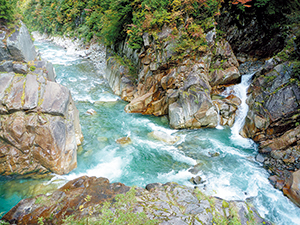
Jyuji-kyo Gorge (Kurobe River)
The central region of the park is marked by numerous rivers of abundant water flow threading though deep V-shaped valleys as the Kurobe River flows to the north, Azusa River to the south, Takase River to the east, and the Kamata River to the west forming a magnificent mountain landscape surrounded by rocky peaks rising sheer and vast highlands.
The park lies within the heavy snowfall mountain terrain, and so some snow lingers during the summer, and the area is dotted with small to large gorges as represented by Japan's three famous snowy gorges, which are Tsurugi-sawa Daisekkei Gorge, Hakuba Daisekkei Gorge, and the Harinoki Daisekkei Gorge. Other features are the cirques and glacial troughs formed by glaciers as typified by the cirques found on Mt. Tateyama, Mt. Yakushi , and Karasawa, as well as the glacial troughs on Yarisawa and Mt. Tateyama.
The park lies within the heavy snowfall mountain terrain, and so some snow lingers during the summer, and the area is dotted with small to large gorges as represented by Japan's three famous snowy gorges, which are Tsurugi-sawa Daisekkei Gorge, Hakuba Daisekkei Gorge, and the Harinoki Daisekkei Gorge. Other features are the cirques and glacial troughs formed by glaciers as typified by the cirques found on Mt. Tateyama, Mt. Yakushi , and Karasawa, as well as the glacial troughs on Yarisawa and Mt. Tateyama.
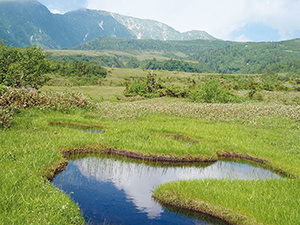
Midagahara Plain (lava plateau)
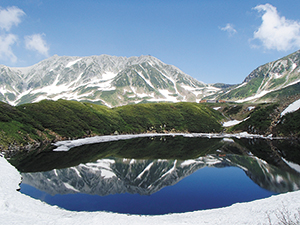
Mikuriga Pond (crater lake)
Also, volcanoes dot the area adding variations to the terrain. Mt. Yakedake, which banked up the Azusa River by eruption forming the Taisho Pond, still shows signs of volcanic activity even now. The vicinity of Mt. Tateyama is also a sight to behold fumarole phenomena and crater lakes in Jigokudani and lava plateaus in Midagahara Plain, making it one of the foremost picturesque places in the park.
Plants
Chubusangaku National Park boasts the expansive primeval nature marked with variations and encompasses a diverse range of vegetation zones depending on elevation. The alpine belt beyond 2,500 m above sea level is inhabited by clusters of creeping pine trees and alpine belt, as well as a subalpine coniferous forest dominated by the Abies veitchiiand and Abies mariesii along with Erman's birch forests at altitudes between 1,500 m and 2,500 m above sea level, while the area at 1,500 meters elevation and below creates a habitat for a summer-green broadleaf forest consisting mainly of Japanese beech trees and Quercus crispula blume trees.
The park's alpine belt is a sight to observe a variety of flora corresponding to the difference in environment such as the topography, geological features and snow depth. In particular, a stretch of Mt. Shirouma is famed for its abundance of alpine plants where alpine belt and the flora named after Mt. Shirouma, such as Allium schoenoprasum var. orientale and Gentianopsis yabei f. violacea are lined in perfect harmony.
The park's alpine belt is a sight to observe a variety of flora corresponding to the difference in environment such as the topography, geological features and snow depth. In particular, a stretch of Mt. Shirouma is famed for its abundance of alpine plants where alpine belt and the flora named after Mt. Shirouma, such as Allium schoenoprasum var. orientale and Gentianopsis yabei f. violacea are lined in perfect harmony.
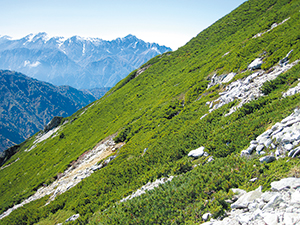
Clusters of Creeping Pine (Mt. Karamatsu)
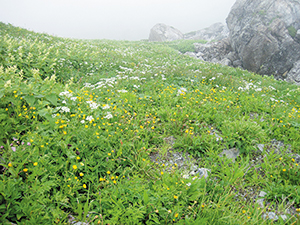
Alpine Belt (Nebukappira, Mt. Shirouma)
Added to the appeal is a riparian forest as typified by the Salix arbutifolia growing along the Azusa River and the vegetation unique to wetlands in Kumonotaira and Tsurugaike.
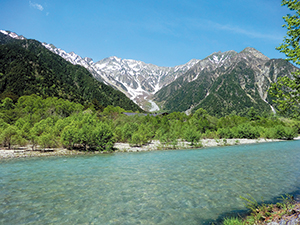
A Riparian Forest of Salix arbutifolia in Kamikochi
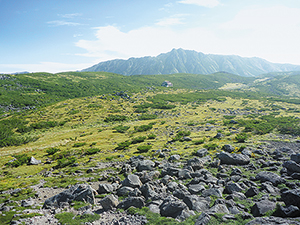
Vegetation of the Kumonotaira Wetlands
Wildlife
The park is a habitat for mammals such as Asian black bear, Japanese serow, Japanese macaque, and the stoat and birds such as the golden eagle and mountain hawk-eagle, as well as rock ptarmigan and spotted nutcracker. The fish found in a mountain stream include Salvelinus leucomaenis pluvius and Japanese fluvial sculpin.
The park is marked by the habitats for wildlife mainly native to the alpine belt, including rock ptarmigan, alpine butterflies such as poplar admiral, asamana arctic, and the Colias palaeno.
The park is marked by the habitats for wildlife mainly native to the alpine belt, including rock ptarmigan, alpine butterflies such as poplar admiral, asamana arctic, and the Colias palaeno.
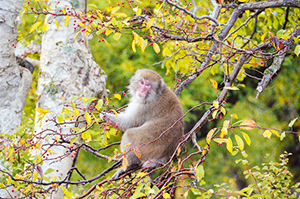
Japanese Macaque
Culture
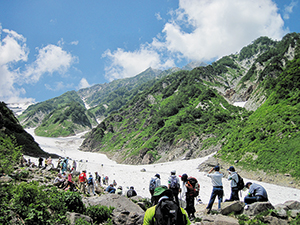
Mt. Shirouma is visited by hordes of mountaineers
Traditionally, the mountains such as Mt. Tateyama, Mt. Kasagadake and Mt. Yarigatake were worshiped as a sacred mountain and during the Edo era, throngs of pilgrims made their way to the summit of the Mt. Tateyama in particular, known as the Japan's "Three Sacred Mountains," alongside Mt. Fuji and Mt. Hakusan.

A memorial Plaque of Walter Weston
Dating back to the Meiji era, an English mining engineer, William Gowland, who is said to have made the first recorded ascent on peaks in a Western-style in Japan, named the mountains the Japanese Alps including the national park area. The name was later introduced widely to the world by English missionary Walter Weston, attracting a host of mountaineers as Japan's mecca for modern mountain climbing.
